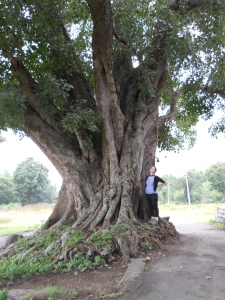Later in the day on Wednesday, we tried to get to another nearby wildlife sanctuary, Nagarhole. Travelling on many back roads, with road blocks of cows and goats, proved to be a difficult task, and we weren’t able to make it there. Alas our trip was not in vain- we were able to see locals threshing grains by laying them across the road and using the weight of passing cars to separate and crush the grains. It was quite an interesting and novel idea to complete a difficult task otherwise done by hand. We also found a large body of water that was host to many lotus plants. How beautiful it would have been to see this in bloom in the warmer months, but it was still impressive as our photo shows.
On Thursday morning, we pack up and head to Mudumalai National Park, which is just about an hour away from Bandipur but in another state. We crossed from Karnataka to Tamil Nadu, and noted a completely different landscape. The terrain is much more varying, with mountains as a backdrop to very lush forests. This park is the convergence of the Eastern and Western Ghats, and makes for an interestingly biodiverse habitat. Outside of our host lodge, we found small community temple surrounded by Buddha figs (Ficus religiosa) and banyons (Ficus bengalensis).
Later in the evening, we were privy to visit the government’s elephant training facility. These elephants are really quite smart; they happily get bathed in the river by their owners and they anxiously open their mouths during feeding times. Beyond trained elephants, we have seen quite a few wild elephant herds. I didn’t realize that elephants got more spots on their head and ears as they age.
On Friday we were able to get a little more information on some of the local vegetation.
Our lodge provided an interpretive walk and we were eagerly trod through the brush and mud learning local names to some we could recognize and some that were foreign to our eyes. Some of the interesting things that perked our attention were the many ayurvedic uses for the plants, some for memory enhancement others for antiseptic purposes to name a few. We hope to have a lot more information on display in the coming Tropical Forest India exhibit opening in early 2012!





In the elephant’s photo it appears that its tusks were trimmed back. Why is that?
Thanks for the question Suzanne. While we have seen many wild elephants none have been full grown “Tuskers” or adult male elephants. Not to mention the wild ones don’t stand still for photos. At the training camp i was told the tusks are trimmed to ensure safety for their handler and those involved in training. An interesting story in the local paper for the last two days was about a 26 year old young tusker who had strayed 60 km from its home in a national forest. This was a record distance through towns and across highways. The Elephant was rounded up with some of the same trained elephants that we had just seen the day before. The wild elephant was safely released back into the National park without any injury to people. That’s after it had it’s fill of some of the local farmer’s sugar cane fields.
Nice Sharing……. I like your blog very much….